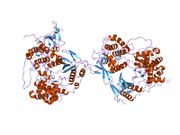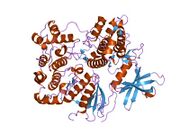Biology:MAPKAPK2
 Generic protein structure example |
MAP kinase-activated protein kinase 2 is an enzyme that in humans is encoded by the MAPKAPK2 gene.[1][2][3]
Function
This gene encodes a member of the Ser/Thr protein kinase family. This kinase is regulated through direct phosphorylation by p38 MAP kinase. In conjunction with p38 MAP kinase, this kinase is known to be involved in many cellular processes including stress and inflammatory responses, nuclear export, gene expression regulation and cell proliferation. Heat shock protein HSP27 was shown to be its major direct substrate in vivo. Two transcript variants encoding two different isoforms have been found for this gene.[4]
Vascular barrier
MK2 pathway has been demonstrated to have a key role in maintaining and repairing the integrity of endothelial barrier in the lung via actin[5] and vimentin remodeling. Activation of MK2 via its phosphorylation by p38 has been shown to restore the vascular barrier[3] and repair vascular leak,[6] associated with over 60 medical conditions, including Acute Respiratory Distress Syndrome (ARDS), a major cause of death around the world.[7]
SASP initiation
MAPKAPK2 mediates the initiation of the senescence-associated secretory phenotype (SASP) by mTOR (mechanistic target of rapamycin).[8][9] Interleukin 1 alpha (IL1A) is found on the surface of senescent cells, where it contributes to the production of SASP factors due to a positive feedback loop with NF-κB.[10][11] Translation of mRNA for IL1A is highly dependent upon mTOR activity.[12] mTOR activity increases levels of IL1A, mediated by MAPKAPK2.[10]
See also
- SB 203580, suppresses the activation of MAPKAPK2
- MK2-AP directly activates MAPKAPK2 independent of p38.[3]
Interactions
MAPKAPK2 has been shown to interact with:
References
- ↑ "The primary structure of a human MAP kinase activated protein kinase 2". Biochemical and Biophysical Research Communications 200 (2): 1118–24. April 1994. doi:10.1006/bbrc.1994.1566. PMID 8179591.
- ↑ "The substrate specificity and structure of mitogen-activated protein (MAP) kinase-activated protein kinase-2". The Biochemical Journal 296 ( Pt 3) (Pt 3): 843–9. December 1993. doi:10.1042/bj2960843. PMID 8280084.
- ↑ 3.0 3.1 3.2 "Anthrax lethal toxin-induced lung injury and treatment by activating MK2". Journal of Applied Physiology 119 (4): 412–9. August 2015. doi:10.1152/japplphysiol.00335.2015. PMID 26066827.
- ↑ "Entrez Gene: MAPKAPK2 mitogen-activated protein kinase-activated protein kinase 2". https://www.ncbi.nlm.nih.gov/sites/entrez?Db=gene&Cmd=ShowDetailView&TermToSearch=9261.
- ↑ "Smooth muscle alpha-actin expression and myofibroblast differentiation by TGFbeta are dependent upon MK2". Journal of Cellular Biochemistry 100 (6): 1581–92. April 2007. doi:10.1002/jcb.21154. PMID 17163490.
- ↑ "Anthrax lethal toxin disrupts the endothelial permeability barrier through blocking p38 signaling". Journal of Cellular Physiology 227 (4): 1438–45. April 2012. doi:10.1002/jcp.22859. PMID 21618534.
- ↑ "Fifty Years of Research in ARDS. The Epidemiology of Acute Respiratory Distress Syndrome. A 50th Birthday Review". American Journal of Respiratory and Critical Care Medicine 195 (7): 860–870. April 2017. doi:10.1164/rccm.201609-1773CP. PMID 28157386.
- ↑ "Polyphenols as Caloric-Restriction Mimetics and Autophagy Inducers in Aging Research". Nutrients 12 (5): 1344. May 2020. doi:10.3390/nu12051344. PMID 32397145.
- ↑ "mTOR as a central regulator of lifespan and aging". F1000Research 8: 998. 2019. doi:10.12688/f1000research.17196.1. PMID 31316753.
- ↑ 10.0 10.1 "MTOR regulates the pro-tumorigenic senescence-associated secretory phenotype by promoting IL1A translation". Nature Cell Biology 17 (8): 1049–61. August 2015. doi:10.1038/ncb3195. PMID 26147250.
- ↑ "Rapamycin inhibits the secretory phenotype of senescent cells by a Nrf2-independent mechanism". Aging Cell 16 (3): 564–574. June 2017. doi:10.1111/acel.12587. PMID 28371119.
- ↑ "Rapamycin and the inhibition of the secretory phenotype". Experimental Gerontology 94: 89–92. August 2017. doi:10.1016/j.exger.2017.01.026. PMID 28167236.
- ↑ 13.0 13.1 "p38 Kinase-dependent MAPKAPK-2 activation functions as 3-phosphoinositide-dependent kinase-2 for Akt in human neutrophils". The Journal of Biological Chemistry 276 (5): 3517–23. February 2001. doi:10.1074/jbc.M005953200. PMID 11042204.
- ↑ "Cell type-specific inhibition of the ETS transcription factor ER81 by mitogen-activated protein kinase-activated protein kinase 2". The Journal of Biological Chemistry 276 (45): 41856–61. November 2001. doi:10.1074/jbc.M106630200. PMID 11551945.
- ↑ 15.0 15.1 "P66(ShcA) interacts with MAPKAP kinase 2 and regulates its activity". FEBS Letters 564 (1–2): 205–11. April 2004. doi:10.1016/S0014-5793(04)00351-5. PMID 15094067.
- ↑ "MK2 phosphorylation of RIPK1 regulates TNF-mediated cell death". Nature Cell Biology 19 (10): 1237–1247. October 2017. doi:10.1038/ncb3608. PMID 28920952.
Further reading
- "Deficiency of MAPK-activated protein kinase 2 (MK2) prevents adverse remodelling and promotes endothelial healing after arterial injury". Thrombosis and Haemostasis 112 (6): 1264–76. December 2014. doi:10.1160/TH14-02-0174. PMID 25120198.
- "Nuclear export of the stress-activated protein kinase p38 mediated by its substrate MAPKAP kinase-2". Current Biology 8 (19): 1049–57. September 1998. doi:10.1016/S0960-9822(98)70442-7. PMID 9768359.
- "Identification of MAPKAP kinase 2 as a major enzyme responsible for the phosphorylation of the small mammalian heat shock proteins". FEBS Letters 313 (3): 307–13. November 1992. doi:10.1016/0014-5793(92)81216-9. PMID 1332886.
- "Phosphorylation of tyrosine hydroxylase by calmodulin-dependent multiprotein kinase". The Journal of Biological Chemistry 259 (22): 13680–3. November 1984. doi:10.1016/S0021-9258(18)89798-8. PMID 6150037.
- "Constitutive activation of mitogen-activated protein kinase-activated protein kinase 2 by mutation of phosphorylation sites and an A-helix motif". The Journal of Biological Chemistry 270 (45): 27213–21. November 1995. doi:10.1074/jbc.270.45.27213. PMID 7592979.
- "Modulation of cellular thermoresistance and actin filament stability accompanies phosphorylation-induced changes in the oligomeric structure of heat shock protein 27". Molecular and Cellular Biology 15 (1): 505–16. January 1995. doi:10.1128/MCB.15.1.505. PMID 7799959.
- "Phosphorylation and activation of human tyrosine hydroxylase in vitro by mitogen-activated protein (MAP) kinase and MAP-kinase-activated kinases 1 and 2". European Journal of Biochemistry 217 (2): 715–22. October 1993. doi:10.1111/j.1432-1033.1993.tb18297.x. PMID 7901013.
- "Stress- and mitogen-induced phosphorylation of the small heat shock protein Hsp25 by MAPKAP kinase 2 is not essential for chaperone properties and cellular thermoresistance". The EMBO Journal 13 (1): 54–60. January 1994. doi:10.1002/j.1460-2075.1994.tb06234.x. PMID 7905823.
- "Interleukin-1 activates a novel protein kinase cascade that results in the phosphorylation of Hsp27". Cell 78 (6): 1039–49. September 1994. doi:10.1016/0092-8674(94)90278-X. PMID 7923354.
- "A growth factor-induced kinase phosphorylates the serum response factor at a site that regulates its DNA-binding activity". Molecular and Cellular Biology 13 (10): 6260–73. October 1993. doi:10.1128/mcb.13.10.6260. PMID 8413226.
- "The p38/RK mitogen-activated protein kinase pathway regulates interleukin-6 synthesis response to tumor necrosis factor". The EMBO Journal 15 (8): 1914–23. April 1996. doi:10.1002/j.1460-2075.1996.tb00542.x. PMID 8617238.
- "Identification of novel phosphorylation sites required for activation of MAPKAP kinase-2". The EMBO Journal 14 (23): 5920–30. December 1995. doi:10.1002/j.1460-2075.1995.tb00280.x. PMID 8846784.
- "FGF and stress regulate CREB and ATF-1 via a pathway involving p38 MAP kinase and MAPKAP kinase-2". The EMBO Journal 15 (17): 4629–42. September 1996. doi:10.1002/j.1460-2075.1996.tb00840.x. PMID 8887554.
- "LSP1 is the major substrate for mitogen-activated protein kinase-activated protein kinase 2 in human neutrophils". The Journal of Biological Chemistry 272 (1): 17–9. January 1997. doi:10.1074/jbc.272.1.17. PMID 8995217.
- "Chemotactic peptide N-formyl-met-leu-phe activation of p38 mitogen-activated protein kinase (MAPK) and MAPK-activated protein kinase-2 in human neutrophils". The Journal of Biological Chemistry 272 (2): 937–44. January 1997. doi:10.1074/jbc.272.2.937. PMID 8995385.
- "Leptomycin B-sensitive nuclear export of MAPKAP kinase 2 is regulated by phosphorylation". The EMBO Journal 17 (12): 3363–71. June 1998. doi:10.1093/emboj/17.12.3363. PMID 9628873.
- "p38 MAPK is required for CD40-induced gene expression and proliferation in B lymphocytes". Journal of Immunology 161 (7): 3225–36. October 1998. doi:10.4049/jimmunol.161.7.3225. PMID 9759836.
- "MAPKAP kinase 2 phosphorylates serum response factor in vitro and in vivo". The Journal of Biological Chemistry 274 (20): 14434–43. May 1999. doi:10.1074/jbc.274.20.14434. PMID 10318869.
 |








